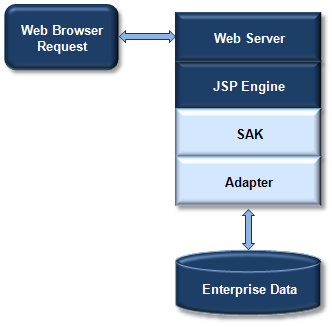Java Server Pages
The installation process guides you through a procedure that deploys Info*Engine as a web application. Going through the installation process sets up your web server and its servlet engine to identify Info*Engine requests and pass those requests on to Info*Engine components for processing. This sets up your Info*Engine environment so that the requests from web browsers to execute JSP and HTML pages are processed correctly.
The following diagram shows the relationships among the components that process web browser requests for JSP pages:
This diagram shows the components that are used when a request specifies that Info*Engine execute a JSP page. By default, Info*Engine and web server configuration specifies that JSP pages are processed in the JSP engine of the Tomcat servlet engine installed within the Windchill Method Server. The JSP engine creates an instance of the SAK, which is then used to execute the Info*Engine-specific code on the page. For example, if a user clicks a link or uses a URL in a browser window that serves as a JSP request for information from Info*Engine, the JSP engine and the SAK work together to manage the request.
The SAK processes the request and, as needed, connects to specialized Info*Engine adapters that communicate with external applications such as Oracle databases, PDM systems, various legacy systems, and ERP systems. After the requested information is obtained from the external applications, the process reverses itself and ultimately displays information in the user’s browser window.

